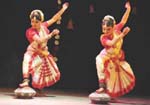“Rabindra Abhivyakti” staged
 Many years after his death, Rabindranath Tagore’s works are still being explored. A recent production “Rabindra Abhivyakti” used the idiom of music and dance to focus on the less-known spiritual philosophy of the bard. Explains Odissi exponent, “yogi” and “spiritualist” Reela Hota, who conceptualised the presentation along with her
Many years after his death, Rabindranath Tagore’s works are still being explored. A recent production “Rabindra Abhivyakti” used the idiom of music and dance to focus on the less-known spiritual philosophy of the bard. Explains Odissi exponent, “yogi” and “spiritualist” Reela Hota, who conceptualised the presentation along with her
mother Bijoylaxmi Hota, “While the aesthetic value of Tagore’s works has been highlighted, not enough importance has been given to explain the spiritual and yogic
significance of his poems through different art forms. We at Rays of Wisdom Society have made an attempt to present this aspect of his through a never-before multi-art
presentation of Odissi, Kathak, Gaudiya Nritya, Pung Chalom and creative dance.”
Rays of Wisdom Society, of which Reela is secretary, is slanted at reviving the spiritual aspect of the arts — whether music, dance, drama or painting. The aim of
“Rabindra Abhivyakti” was in Reela’s words, “To establish Tagore as an enlightened man and role model for artists of today. Art is meant to accelerate human evolution.
However, if the focus is on the material in art, one evolves accordingly.”
The recent production comprised of “Mangalacharan”, an invocation to Goddess Saraswati, the goddess of knowledge and arts, which went on to describe the experience of
a Nada Yogi devotee. The Tagore works were “Dui Pakhi”, “Nirjharer Swapnabhanga”, “Rath Jatra” and “Mokshya”, which traced the progress of an individual soul from
bondage to liberation or the transcendental state.
Reela excelled in the opening Odissi “Mangalacharan”, while the other pieces lacked an edge. If Reela was the bright spark in the production, the viewer’s attention
flagged as the other dancers went through their Kathak, Gaudiya Nritya, Pung Chalom and creative dance moves. The recorded music composed by renowned classical
vocalists Pandit Rajan and Sajan Mishra, redeemed the evening.
If the execution of “Rabindra Abhivyakti” went haywire at times, it is impossible to fault the concept and design by Reela and her mother, a yoga and meditation guru
with several books on yoga to her credit. A lot of hard work went in to the production, says Reela since she is neither a Tagore scholar nor a Bengali. Extensive
research was therefore needed towards which end the mother-daughter duo sat across the table with Tagore scholars. “Many people said that there is much more to Tagore
than beautiful poetry,” says Reela.
One only wishes that the other dancers had done justice to a fine idea.
-With The Daily Star input




















